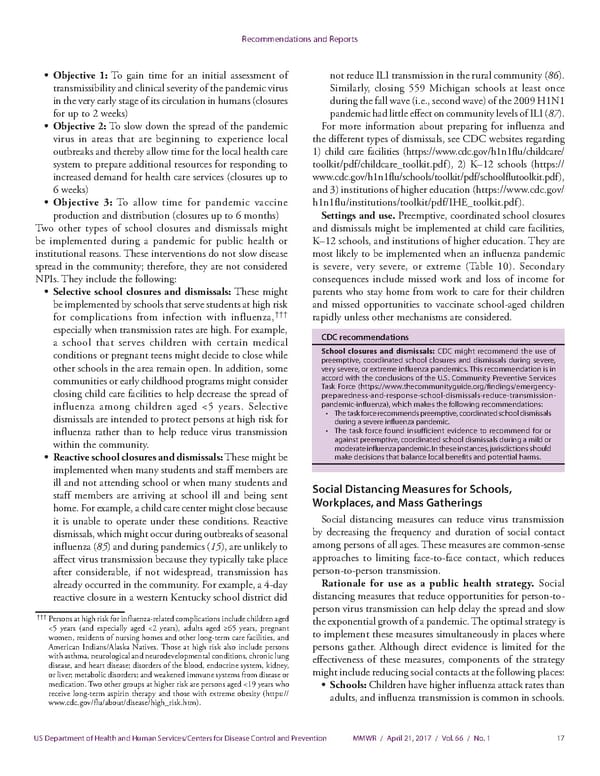Recommendations and Reports • Objective 1: To gain time for an initial assessment of not reduce ILI transmission in the rural community (86). transmissibility and clinical severity of the pandemic virus Similarly, closing 559 Michigan schools at least once in the very early stage of its circulation in humans (closures during the fall wave (i.e., second wave) of the 2009 H1N1 for up to 2 weeks) pandemic had little effect on community levels of ILI (87). • Objective 2: To slow down the spread of the pandemic For more information about preparing for influenza and virus in areas that are beginning to experience local the different types of dismissals, see CDC websites regarding outbreaks and thereby allow time for the local health care 1) child care facilities (https://www.cdc.gov/h1n1flu/childcare/ system to prepare additional resources for responding to toolkit/pdf/childcare_toolkit.pdf), 2) K–12 schools (https:// increased demand for health care services (closures up to www.cdc.gov/h1n1flu/schools/toolkit/pdf/schoolflutoolkit.pdf), 6 weeks) and 3) institutions of higher education (https://www.cdc.gov/ • Objective 3: To allow time for pandemic vaccine h1n1flu/institutions/toolkit/pdf/IHE_toolkit.pdf). production and distribution (closures up to 6 months) Settings and use. Preemptive, coordinated school closures Two other types of school closures and dismissals might and dismissals might be implemented at child care facilities, be implemented during a pandemic for public health or K–12 schools, and institutions of higher education. They are institutional reasons. These interventions do not slow disease most likely to be implemented when an influenza pandemic spread in the community; therefore, they are not considered is severe, very severe, or extreme (Table 10). Secondary NPIs. They include the following: consequences include missed work and loss of income for • Selective school closures and dismissals: These might parents who stay home from work to care for their children be implemented by schools that serve students at high risk and missed opportunities to vaccinate school-aged children ††† for complications from infection with influenza, rapidly unless other mechanisms are considered. especially when transmission rates are high. For example, a school that serves children with certain medical CDC recommendations conditions or pregnant teens might decide to close while School closures and dismissals: CDC might recommend the use of preemptive, coordinated school closures and dismissals during severe, other schools in the area remain open. In addition, some very severe, or extreme influenza pandemics. This recommendation is in communities or early childhood programs might consider accord with the conclusions of the U.S. Community Preventive Services Task Force (https://www.thecommunityguide.org/findings/emergency- closing child care facilities to help decrease the spread of preparedness-and-response-school-dismissals-reduce-transmission- influenza among children aged <5 years. Selective pandemic-influenza), which makes the following recommendations: dismissals are intended to protect persons at high risk for • The task force recommends preemptive, coordinated school dismissals during a severe influenza pandemic. influenza rather than to help reduce virus transmission • The task force found insufficient evidence to recommend for or within the community. against preemptive, coordinated school dismissals during a mild or moderate influenza pandemic. In these instances, jurisdictions should • Reactive school closures and dismissals: These might be make decisions that balance local benefits and potential harms. implemented when many students and staff members are ill and not attending school or when many students and Social Distancing Measures for Schools, staff members are arriving at school ill and being sent Workplaces, and Mass Gatherings home. For example, a child care center might close because it is unable to operate under these conditions. Reactive Social distancing measures can reduce virus transmission dismissals, which might occur during outbreaks of seasonal by decreasing the frequency and duration of social contact influenza (85) and during pandemics (15), are unlikely to among persons of all ages. These measures are common-sense affect virus transmission because they typically take place approaches to limiting face-to-face contact, which reduces after considerable, if not widespread, transmission has person-to-person transmission. already occurred in the community. For example, a 4-day Rationale for use as a public health strategy. Social reactive closure in a western Kentucky school district did distancing measures that reduce opportunities for person-to- person virus transmission can help delay the spread and slow ††† Persons at high risk for influenza-related complications include children aged the exponential growth of a pandemic. The optimal strategy is <5 years (and especially aged <2 years), adults aged ≥65 years, pregnant to implement these measures simultaneously in places where women, residents of nursing homes and other long-term care facilities, and American Indians/Alaska Natives. Those at high risk also include persons persons gather. Although direct evidence is limited for the with asthma, neurological and neurodevelopmental conditions, chronic lung effectiveness of these measures, components of the strategy disease, and heart disease; disorders of the blood, endocrine system, kidney, might include reducing social contacts at the following places: or liver; metabolic disorders; and weakened immune systems from disease or medication. Two other groups at higher risk are persons aged <19 years who • Schools: Children have higher influenza attack rates than receive long-term aspirin therapy and those with extreme obesity (https:// adults, and influenza transmission is common in schools. www.cdc.gov/flu/about/disease/high_risk.htm). US Department of Health and Human Services/Centers for Disease Control and Prevention MMWR / April 21, 2017 / Vol. 66 / No. 1 17
 Community Mitigation Guidelines to Prevent Pandemic Influenza Page 18 Page 20
Community Mitigation Guidelines to Prevent Pandemic Influenza Page 18 Page 20